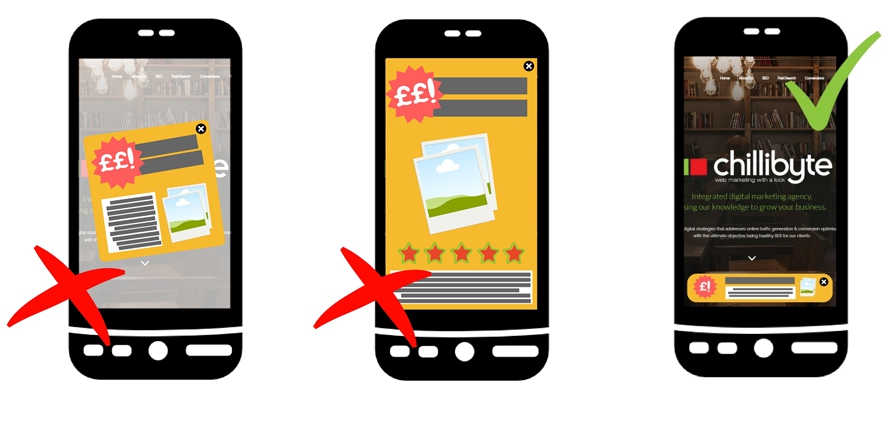
18 Jan How to Avoid Google’s New Penalty for Mobile Popups
Back in August 2016 Google got marketers in a twitch when it unveiled two changes it was to make to mobile search results. Most of you may have noticed that back when this news hit the press, Google had already started implementing change one; removing the ‘mobile friendly’ label from search results, which was originally used to highlight pages that wouldn’t give you brain ache if viewing on a smartphone. The world took this on the chin as Google revealed that 85% of all pages shown on its mobile search results page were already mobile friendly and would continue to use the feature as a ranking factor.
Fast forward nine months to 10th January 2017, the day when Google set change two loose. If you’re a mobile web user, chances are you have entered the blackhole of mobile popups. You’re blissfully scrolling some content before a page-devouring ad interrupts and, whilst jabbing at the most minute exit cross ever, you end up half-way to ordering an orthopaedic mattress and complimentary waterproof sheet. Fantastic.
How Will Google Penalties Impact Offending Websites?

Google’s latest scheme is going to save us all from the depths of mobile browsing despair by dishing out penalties to mobile pages that show intrusive popups or interstitials when a user first lands on the page. Pages that utilise in-your-face and hard-to-escape ads will feel a negative SEO impact and notice a decline in their Google search engine rankings.
Both interstitials and popups that are content-linked, or serve a purpose to the site, will not face penalisation – this also applies to ads that are easy to dismiss and exit. Google-friendly popups can include log-in boxes, legal requirements, or ads that do not encroach drastically on a page.
What Should Marketers Consider with Their Ads?
If you work in advertising or marketing, you need to get in gear and cast an eye over your popups and interstitials, pronto. Reviewing every ad in use (only from SERP to Site) and determining if they fall into the red zone will help distinguish which need deleting, or a quick tweak, to ensure they sit within safe parameters. Check out some of the most frequently asked questions below in light of the latest Google update.
At What Stage Would My Ad Be Disruptive to Content?
Ads that are displayed over the top of main page content and inhibit the continued reading of said content are now forbidden; this includes regular page-landing ads, as well as scrolling ads. The main takeaway is that there should be no barrier between the user and the content.
Will Penalties Apply to Desktop Ads Too?
Intrusive popups and interstitials can still be displayed on desktop browsers without incurring a penalty. This is because, due to screen size, ads are easier to exit on a computer, laptop, or tablet. Therefore, interruptive ads need only be removed from mobile pages.
What About My Interstitials Running Via WP Plugins?
There are a number of WordPress plugins used to display popup messages, promotions, and ads. Sites utilising this type of software will need to either adjust popup sizing using the plugin settings or remove them altogether and consider a different approach.
Will My Exit and Page-to-Page Popups Be Scrutinised Too?
Not only are desktop ads not affected, nor are popups and interstitials triggered by page-to-page activity or exiting. The only ads that will be liable for punishment are those searchers land on from Google search engine results.

No Comments